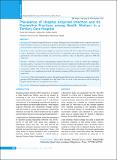Please use this identifier to cite or link to this item:
https://hdl.handle.net/20.500.14356/1489Full metadata record
| DC Field | Value | Language |
|---|---|---|
| dc.contributor.author | Shrestha, Purna Devi | - |
| dc.contributor.author | Rai, Sirjana | - |
| dc.contributor.author | Gaihre, Shobha | - |
| dc.date.accessioned | 2023-05-14T09:02:53Z | - |
| dc.date.available | 2023-05-14T09:02:53Z | - |
| dc.date.issued | 2018 | - |
| dc.identifier.citation | ShresthaP. D., RaiS., & GaihreS. (2019). Prevalence of Hospital Acquired Infection and its Preventive Practices among Health Workers in a Tertiary Care Hospital. Journal of Nepal Health Research Council, 16(41), 452-456. https://doi.org/10.33314/jnhrc.v16i41.1157 | en_US |
| dc.identifier.issn | Print ISSN: 1727-5482; Online ISSN: 1999-6217 | - |
| dc.identifier.uri | http://103.69.126.140:8080/handle/20.500.14356/1489 | - |
| dc.description | Original Article | en_US |
| dc.description.abstract | Abstract Background: Hospital Acquired Infections are major challenge for low and middle income countries which have limited healthcare resources. Literature has explored the prevalence is high and practice is limited. This study aims to assess prevalence and preventive practices of Hospital Acquired Infection among health workers. Methods: A cross -sectional research design was carried out between Feb 2017 to May 2017 in National Trauma Center , Kathmandu. Census method was used to recruit 121 respondents and to find out prevalence. A structured questionnaire and observation checklist was used for data collection. Data was objectively analyzed in SPSS full version 21. Results: Prevalence of bacteria causing Hospital Acquired Infections was 11.83% in critical units. Among 95 specimen analysis, 53 specimen were isolated in critical units. The most common site of infection was the urinary tract 19 (35.8%) and bacteria causing nosocomial infection was Escherichia coli 28.30%. Culture plate was used to obtain environment samples, Out of 9 specimen analysis, Staphylococcus aureus was the most common isolated organism. Level of practice were significantly associated with education, training on HAI, work experience 0.019, 0.026, 0.027 respectively. Conclusions: The study found that prevalence of hospital acquired infection do exist in less percentage but preventive practices of HAI in majority of respondent were fair. Hence, there is a need to raise awareness as well as training on Hospital acquired Infection among health care workers. Keywords: Critical units; hospital acquired Infection; nosocomial Infection; practice; prevention. | en_US |
| dc.language.iso | en | en_US |
| dc.publisher | Nepal Health Research Council | en_US |
| dc.relation.ispartofseries | Oct-Dec 2018;1157 | - |
| dc.subject | Critical units | en_US |
| dc.subject | Hospital acquired Infection | en_US |
| dc.subject | Nosocomial Infection | en_US |
| dc.subject | Practice | en_US |
| dc.subject | Prevention | en_US |
| dc.title | Prevalence of Hospital Acquired Infection and its Preventive Practices among Health Workers in a Tertiary Care Hospital | en_US |
| dc.type | Journal Article | en_US |
| local.journal.category | Original Article | - |
| Appears in Collections: | Vol. 16 No. 4 Issue 41 Oct - Dec 2018 | |
Files in This Item:
| File | Description | Size | Format | |
|---|---|---|---|---|
| 1157-Manuscript-7857-3-10-20190221.pdf | Fulltext Article. | 211.29 kB | Adobe PDF |  View/Open |
Items in DSpace are protected by copyright, with all rights reserved, unless otherwise indicated.
